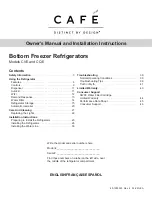
Engine Maintenance (Rev. 04/03)
68
3.
Run clear water into the radiator, and allow it to drain
out of the block and accumulator until it is clear.
4.
Inspect all the hoses for deterioration and the hose
clamp tightness. Replace if necessary.
5.
Loosen the water pump belt. Check the water pump
bearing for looseness.
6.
Inspect the radiator cap. Replace the cap if the gasket
shows any signs of deterioration.
7.
Mix one gallon of permanent type antifreeze concen-
trate meeting GM6038-M specification and one gallon
clean water in a container to make a 50/50 mixture. (Do
not add antifreeze and then add water to the unit. This
procedure may not give a true 50/50 mixture because
the exact cooling system capacity may not always be
known.)
8.
Refill the radiator with the 50/50 mixture.
Antifreeze Maintenance Procedure
As with all equipment containing antifreeze, periodic
inspection on a regular basis is required to verify the condi-
tion of the antifreeze to accomplish these items. After two
years of service, inhibitors become worn out and must be
replaced by changing the antifreeze.
Every two years, the total antifreeze mixture must be
drained, flushed and replaced to maintain total cooling
system protection. When the antifreeze is replaced, use
ethylene glycol type engine coolant concentrate meeting the
GM6038-M specification. The factory recommends the use
of a 50/50 antifreeze mixture in all units even if they are not
exposed to freezing temperatures. Even in summer, the
accumulator tank can get cold enough to freeze the water in
the heat transfer coil. This antifreeze mixture will provide
the required corrosion protection and lubrication for the
water pump.
Checking the antifreeze
Check the solution concentration by using a temperature
compensated antifreeze hydrometer or a refractometer
designed for testing antifreeze. Maintain a minimum mix-
ture of 50% permanent type antifreeze concentrate and 50%
water solution to provide protection to -30 F (-34 C). Do not
mix antifreeze stronger than 68% permanent type coolant
concentrate and 32% water for use in extreme temperatures.
Changing the Antifreeze
1.
Run the engine until it is up to operating temperature.
Stop the unit.
2.
Open the engine block drain and accumulator tank
drain, and completely drain coolant. Observe coolant
color. If the coolant is dirty, proceed with a, b, and c.
Otherwise go to step 3.
CAUTION: Avoid direct contact with hot
coolant.
a.
Run clear water into radiator and accumulator and
allow it to drain out of the block until it is clear.
b.
Close the block drain and install a commercially
available radiator and block flushing agent, and
operate the unit in accordance with instructions of
the flushing agent manufacturer.
c.
Open the engine block and accumulator drain to
drain water and flushing solution.
CAUTION: Avoid direct contact with hot
coolant.
1.
Drain
Accumulator Tank Drain
Summary of Contents for KD-II SR
Page 4: ......
Page 8: ......
Page 13: ...Safety Precautions Rev 04 03 v AEA40...
Page 14: ...Safety Precautions Rev 04 03 vi AEA38...
Page 33: ...Unit Description Rev 04 03 19 1 Evaporator 2 Access Door Rear View Curbside KD II SR 1 2 AEA38...
Page 37: ...Unit Description Rev 04 03 23 Power Receptacle Box KD II SR 50 AEA42...
Page 58: ...Remote Control Panel Features Rev 04 03 44...
Page 112: ...Refrigeration Maintenance Rev 04 03 98...
Page 120: ...106...
Page 146: ...132...
Page 156: ...142...
Page 162: ...148...
Page 170: ...156...
Page 172: ...158...
Page 173: ...159 KD II 30 Schematic Diagram Page 1 of 2...
Page 174: ...160 KD II 30 Schematic Diagram Page 2 of 2...
Page 175: ...161 KD II 30 Wiring Diagram Page 1 of 2...
Page 176: ...162 KD II 30 Wiring Diagram Page 2 of 2...
Page 177: ...163 KD II 50 Schematic Diagram Page 1 of 2...
Page 178: ...164 KD II 50 Schematic Diagram Page 2 of 2...
Page 179: ...165 KD II 50 Wiring Diagram Page 1 of 2...
Page 180: ...166 KD II 50 Wiring Diagram Page 2 of 2...
Page 181: ...167 KD II 50 SR 230 1 60 Wiring Diagram Page 1 of 2...
Page 182: ...168 KD II 50 SR 230 1 60 Wiring Diagram Page 2 of 2...
















































